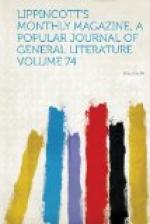and the palms it will drift to the granite portals
that are flanked by the winged Viennese horses and
the colossal figures of Minerva in the act of bridling
them. Pegasus is not very worthily represented
by these bronzes. The horses, however, are the
better part of the two groups; the goddesses being
too tall in proportion and heavy and ungraceful in
build. The finer things which they sentinel, in
bronze, marble or canvas, do not belong to the scope
of this article. Yet we cannot postpone to the
occasion of their notice in detail a tribute to him
to whose energy and judgment we owe the filling of
the Art Building with works fit to be there.
For the accomplishment of this task the principal
credit is due to John Sartain of Philadelphia, the
Nestor of American engravers. But for Mr. Sartain’s
efforts, the studios of the best artists of America,
especially, would have been much less adequately represented,
while the walls would have been in danger of defacement
by a flood of inferior productions. To secure
the best, and the best only, of what artists and collectors
could give, committees were appointed to inspect the
offerings of the principal cities and select works
of real merit. The difficulties in the way are
appreciable only by those familiar with the diversities
of feeling and opinion which are apt to make shipwreck
of art-exhibitions. They have been overcome,
and American artists have united in the practical
measures needed to ensure them as fair a position by
the side of foreign competitors as their actual merits
can sustain.
It could hardly have been a recognition of carriage-making
as one of the fine arts that caused the placing of
an immense receptacle for such vehicles in so prominent
a position near Memorial Hall. This structure
stands opposite the western half of the Main Building.
Combined with the annex erected for a like purpose
by the Bureau of Agriculture, which covers three acres,
it would seem to afford room for specimens of every
construction ever placed on wheels since Pharaoh’s
war-chariots limbered up for the Red Sea campaign.
These collections have no trifling significance as
a sign of progress. They are the product of good
roads, one of the surest traces of civilization.
A century ago, a really good road was almost an unknown
thing. So recently as half so long since one of
the light equipages now so familiar to us would have
been a simple impossibility. What words of ecstasy
Dr. Johnson, who pronounced the height of bliss to
be a drive over a turnpike of his day in a cranky
post-chaise, would have applied to a “spin”
in one of these wagons, no imagination can guess.




